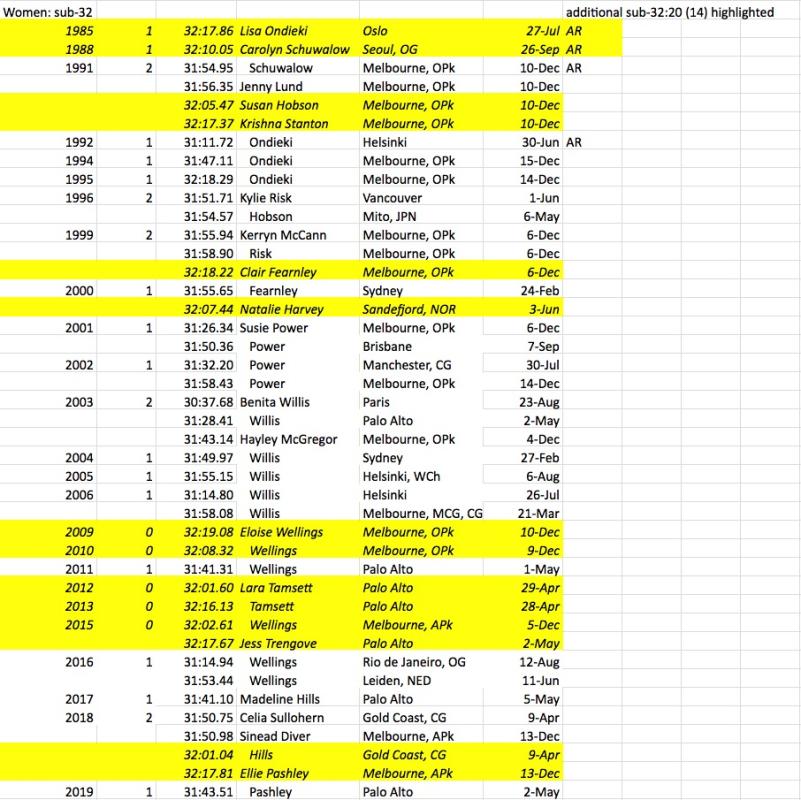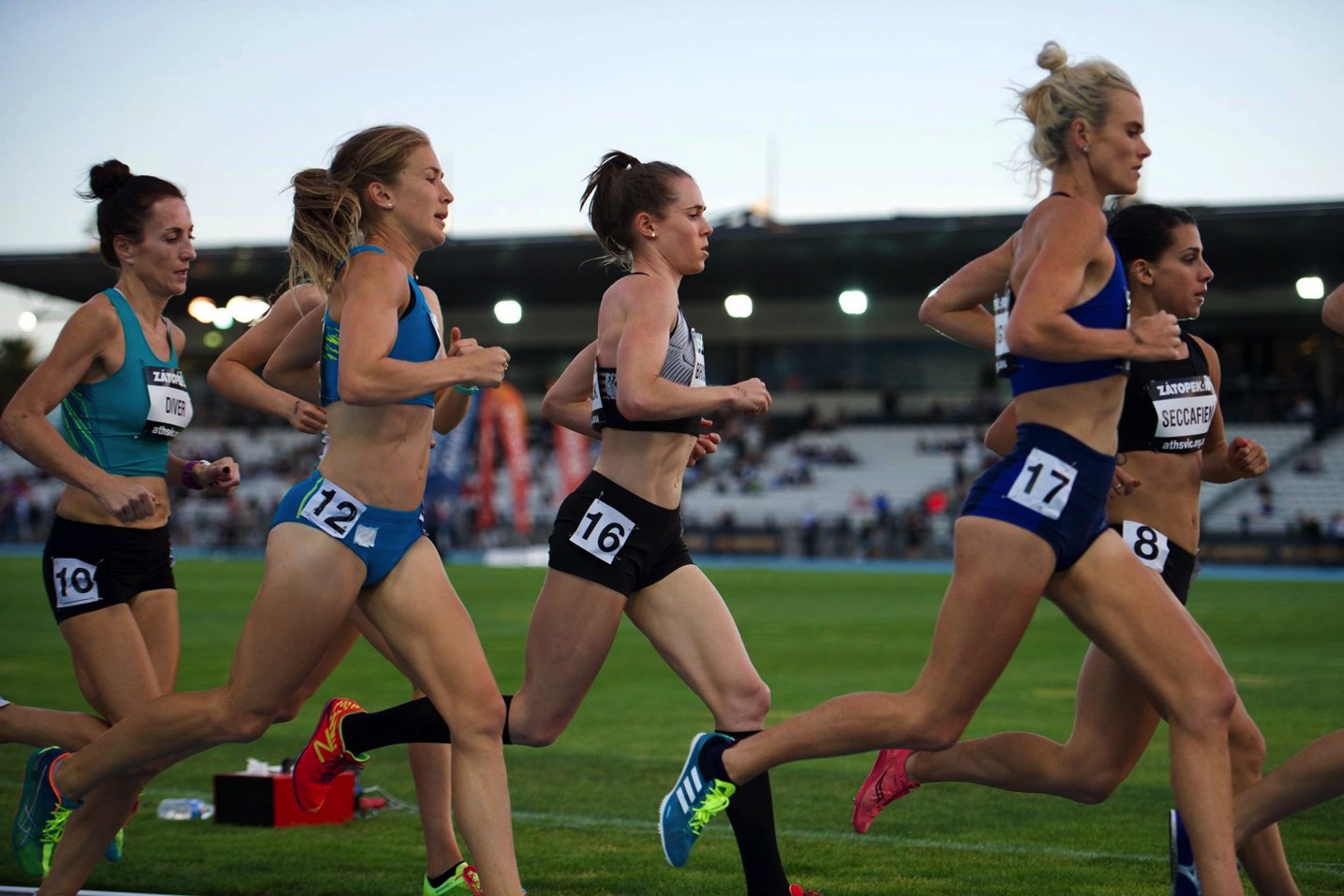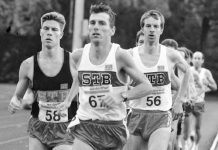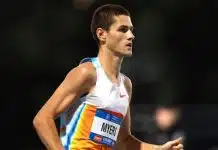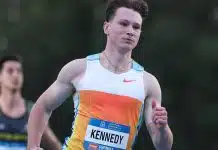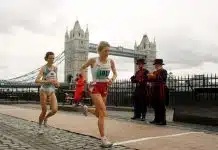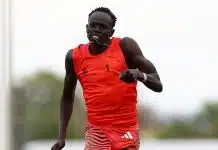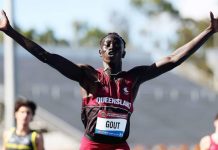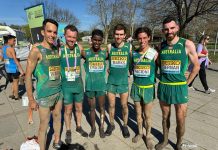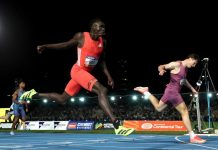Having asked the question last time – “How good is the men’s 10,000” – let’s now turn to how Australian women are faring, and have fared, at the longest track distance.
To recap, the examination of the standard of Australian men’s 10,000 was prompted by Steve Dinneen’s wondering whether the number of Australian men to have bettered 28 minutes in the past 12 months was the most in any similar period in Australia’s distance-running history. Turns out it is.
What’s the equivalent standard for women?
In compiling all-time statistics for the Zatopek 10,000, I count sub-28 and sub-32:30. I used sub-28 for the men’s measure, because that was the framework in which the question was asked. In considering the women, I’ve gone for 32 minutes as the benchmark, adding to the display, but not the count, the women falling between that mark and the IAAF all-time list per country standard of 32:20.
Both these times are reliable measures of what constitutes world-class. They are performances which have been at, or around, the qualifying standard for world Championships and Olympics in recent years.
Broadly, Australian women’s distance running is in good shape. There’s a higher number of ‘world class’ women in the marathon than men: Madeline Hills, Eloise Wellings and Genevieve Lacaze performed brilliantly in the Rio 2016 Olympic year at 5000; Hills and Lacaze did so in the steeple, too. Celia Sullohern, Sinead Diver and Ellie Pashley have followed them more recently.
Diver and Pashley are the only two to have broken 32 minutes in the past 12 months, Diver in winning the Zatopek race in 31:50.98, Pashley in Palo Alto this May in 31:43.51. Extending the rolling 12 months just slightly, Sullohern was sub-32 at the Gold Coast Commonwealth Games, Hills just outside it. There has been three women under 32, compared with four men sub-28.
Let’s wind the clock a little. The 10,000 was not introduced for women at the Olympics until Seoul in 1988. The event began the transition to Olympic status at the 1985 World Cup in Canberra, followed by the European championships and Commonwealth Games in 1986 and the world championships the year after that.
Distance runners were more than ready. Ingrid Kristiansen won at the 1986 Europeans in 30:23.25, less than 10 seconds outside the world record she had set at Oslo a few weeks earlier; Liz Lynch won the Commonwealth gold in 31:41.42. Kristiansen won the first world championship in 31:05.85 but was not at her top in Seoul due to injury, leaving Olga Bondarenko to take the first Olympic gold in 31:05.21 (Bondarenko would have won at the 1985 World Cup, too, but for miscounting the laps and sprinting a lap early, handing victory to Aurora Cunha).
Back to Australia: it was not until 1991, when Carolyn Schuwalow won the Zatopek in an Australian record 31:54.95, that we had our first sub-32. But that would be to ignore two outstanding performances before that. Schuwalow ran 32:10.05 – again a national record – in reaching the Seoul Olympic final (back in the days when the 10,00 had heats!). Three years before that, Lisa Ondieki ran 32:17.86 in Oslo behind Kristiansen, Cunha and Lynn Jennings.
We have never had a calendar year with more than two Australian women below 32 minutes, but have had three on a couple of occasions in the ‘Zatopek-to-Zatopek’ year. Jenny Lund ran sub-32 when finishing second to Schuwalow in the 1991 Zatopek and Ondieki lowered the national record to 31:11.72 in Helsinki in June, 1992.
Again, in 1999-2000, Kerryn McCann and Kylie Risk were sub-32 at the Zatopek and Clair Fearnley, third on that occasion, ran 31:55.65 in taking the national title in Sydney a few months later.
The 1991 women’s race makes any list of all-time great Zatopek races, with the first four under the IAAF’s 32:20 cut-off. Behind Schuwalow and Lund (31:56.35) came Susan Hobson (32:05.47) and Krishna Stanton (32:17.37), recording, till then, the first, second, third and fifth times ever by Australian women.
Benita Willis holds the current national record at 30:37.68, set in finishing eighth in the Paris 2003 world championships, arguably the best championship performance by an Australian woman. Other candidates would be Susie Power’s 31:32.20 for a bronze medal at the 2002 Commonwealth Games in Manchester, Eloise Wellings tenth place in the Rio Olympics in 31:14.94 and Schuwalow’s performance in reaching the Seoul Olympic final.
Looking at eras more broadly, in 1991-92 there were three women – Ondieki, Schuwalow and Lund – active who had broken 32, along with Hobson and Stanton sub-32:20. In 1999-2001, McCann, Risk, Fearnley and Power were all sub-32, with Natalie Harvey at 32:07.44.

Willis, Power and Hayley McGregor all went sub-32 in 2002-03, while the recent past has been as prolific as any other era with Wellings, Hills, Diver, Sullohern and Pashley all under 32 minutes since 2016.
In all, there have been 27 sub-32 performances by 15 different athletes (the corresponding figures for sub-32:20 are 42 and 19). For men’s sub-28, over a longer period by some 20 years, it is 45 and 24.
How good is women’s 10,000, then: roughly as good as men’s, at least on the raw numbers. Ron Clarke’s world records and a trio of Olympic bronze medals to Al Lawrence, Dave Power and Clarke are the only substantive differences.
